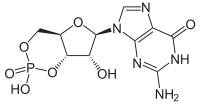Cyclic guanosine monophosphate: Difference between revisions
Script assisted update of chemical identifiers from ChemSpider for the Chem/Drugbox validation project. |
Updating {{chembox}} (no changed fields - added verified revid) per Chem/Drugbox validation (report errors or bugs) |
||
| Line 1: | Line 1: | ||
{{chembox |
{{chembox |
||
| ⚫ | |||
| Watchedfields = changed |
|||
| ⚫ | |||
| ImageFile = CGMP2.svg |
| ImageFile = CGMP2.svg |
||
| ImageSize = 200px |
| ImageSize = 200px |
||
Revision as of 14:33, 27 January 2010

| |
| Names | |
|---|---|
| IUPAC name
2-amino-9-[(1S,6R,8R,9R)-3,9-dihydroxy-3-oxo-2,4,7-trioxa-3λ5-phosphabicyclo[4.3.0]nonan-8-yl]-3H-purin-6-one
| |
| Other names
cGMP; 3',5'-cyclic GMP; Guanosine cyclic monophosphate; Cyclic 3',5'-GMP; Guanosine 3',5'-cyclic phosphate
| |
| Identifiers | |
3D model (JSmol)
|
|
| ChemSpider | |
| ECHA InfoCard | 100.028.765 |
| MeSH | Cyclic+GMP |
PubChem CID
|
|
CompTox Dashboard (EPA)
|
|
| |
| |
| Properties | |
| C10H12N5O7P | |
| Molar mass | 345.208 g·mol−1 |
Except where otherwise noted, data are given for materials in their standard state (at 25 °C [77 °F], 100 kPa).
| |
Cyclic guanosine monophosphate (cGMP) is a cyclic nucleotide derived from guanosine triphosphate (GTP). cGMP acts as a second messenger much like cyclic AMP, most notably by activating intracellular protein kinases in response to the binding of membrane-impermeable peptide hormones to the external cell surface.[1]
Synthesis
cGMP synthesis is catalyzed by guanylate cyclase (GC), which converts GTP to cGMP. Membrane-bound GC is activated by peptide hormones such as the atrial natriuretic factor, while soluble GC is typically activated by nitric oxide to stimulate cGMP synthesis.
Effects
cGMP is a common regulator of ion channel conductance, glycogenolysis, and cellular apoptosis. It also relaxes smooth muscle tissues. In blood vessels, relaxation of vascular smooth muscles lead to vasodilation and increased blood flow.
cGMP is a secondary messenger in phototransduction in the eye. In the photoreceptors of the mammalian eye, the presence of light activates phosphodiesterase, which degrades cGMP. The calcium ion channels in photoreceptors are cGMP-gated, so degradation of cGMP causes calcium channels to close, which leads to the hyperpolarization of the photoreceptor's plasma membrane and ultimately to visual information being sent to the brain.[2] GMP and a number of its derivatives also have an umami taste.[3]
cGMP is also seen to mediate the switching on of the attraction of apical dendrites of pyramidal cells in cortical layer V towards semaphorin-3A (Sema3a).[citation needed] Whereas the axons of pyramidal cells are repelled by Sema3a, the apical dendrites are attracted to it. The attraction is mediated by the increased levels of soluble guanylate cyclase (SGC) that are present in the apical dendrites. SGC generates cGMP, leading to a sequence of chemical activations that result in the attraction towards Sema3a. The absence of SGC in the axon causes the repulsion from Sema3a. This strategy ensures the structural polarization of pyramidal neurons and takes place in embryonic development.
Degradation
Numerous cyclic nucleotide phosphodiesterases (PDE) can degrade cGMP by hydrolyzing cGMP into 5'-GMP. PDE 5, -6 and -9 are cGMP-specific while PDE1, -2, -3, -10 and -11 can hydrolyse both cAMP and cGMP.
Phosphodiesterase inhibitors prevent the degradation of cGMP, thereby enhancing and/or prolonging its effects. For example, Sildenafil (Viagra) enhances the vasodilatory effects of cGMP within the corpus cavernosum by inhibiting PDE 5 (or PDE V). This is used as a treatment for erectile dysfunction. However, the drug can inhibit PDE6 in retina (albeit with less affinity than PDE5). This has been shown to result in loss sensitivity but is unlikely to impair common visual tasks, except under conditions of reduced visibility when objects are already near visual threshold.[4] This effect is largely avoided by other PDE5 inhibitors, such as tadalafil.[5]
Protein kinase activation
cGMP is involved in the regulation of some protein-dependent kinases. For example, PKG (protein kinase G) is a dimer consisting of one catalytic and one regulatory unit, with the regulatory units blocking the active sites of the catalytic units.
cGMP binds to sites on the regulatory units of PKG and activates the catalytic units, enabling them to phosphorylate their substrates. Unlike with the activation of some other protein kinases, notably PKA, the PKG is activated but the catalytic and regulatory units do not disassociate.
References
- ^ Francis SH, Corbin JD (1999). "Cyclic nucleotide-dependent protein kinases: intracellular receptors for cAMP and cGMP action". Crit Rev Clin Lab Sci. 36 (4): 275–328. doi:10.1080/10408369991239213. ISSN 1040-8363. PMID 10486703.
{{cite journal}}: Unknown parameter|month=ignored (help) - ^ R. Lane Brown, Timothy Strassmaier, James D. Brady, Jeffrey W. Karpen (2006). "The Pharmacology of Cyclic Nucleotide-Gated Channels: Emerging from the Darkness". Current Pharmaceutical Design. 12 (28): 3597–613. doi:10.2174/138161206778522100. PMC 2467446. PMID 17073662. NIHMSID: NIHMS47625.
{{cite journal}}: CS1 maint: multiple names: authors list (link) - ^ Cairoli P, Pieraccini S, Sironi M, Morelli CF, Speranza G, Manitto P (2008). "Studies on umami taste. Synthesis of new guanosine 5'-phosphate derivatives and their synergistic effect with monosodium glutamate". J. Agric. Food Chem. 56 (3): 1043–50. doi:10.1021/jf072803c. ISSN 0021-8561. PMID 18181569.
{{cite journal}}: Unknown parameter|month=ignored (help)CS1 maint: multiple names: authors list (link) - ^ Stockman, A; Sharpe, LT; Tufail, A; Kell, PD; Ripamonti, C; Jeffery, G (2007). "The effect of sildenafil citrate (Viagra) on visual sensitivity" (Free full text). J Vis. 7 (8): 4. doi:10.1167/7.8.4. PMID 17685811.
{{cite journal}}: More than one of|author=and|last1=specified (help); Unknown parameter|month=ignored (help) - ^ Daugan, A; Grondin, P; Ruault, C; Le Monnier De Gouville, AC; Coste, H; Linget, JM; Kirilovsky, J; Hyafil, F; Labaudinière, R (2003). "The discovery of tadalafil: a novel and highly selective PDE5 inhibitor. 2: 2,3,6,7,12,12a-hexahydropyrazino[1',2':1,6]pyrido[3,4-b]indole-1,4-dione analogues". J Med Chem. 46 (21): 4533–42. doi:10.1021/jm0300577. ISSN 0022-2623. PMID 14521415.
{{cite journal}}: More than one of|author=and|last1=specified (help); Unknown parameter|month=ignored (help)
See also
- Cyclic adenosine monophosphate (cAMP)
- 8-Bromoguanosine 3',5'-cyclic monophosphate (8-Br-cGMP)
